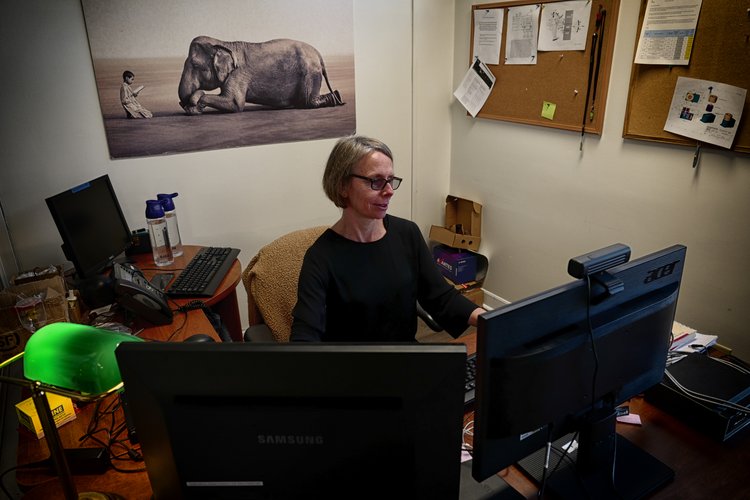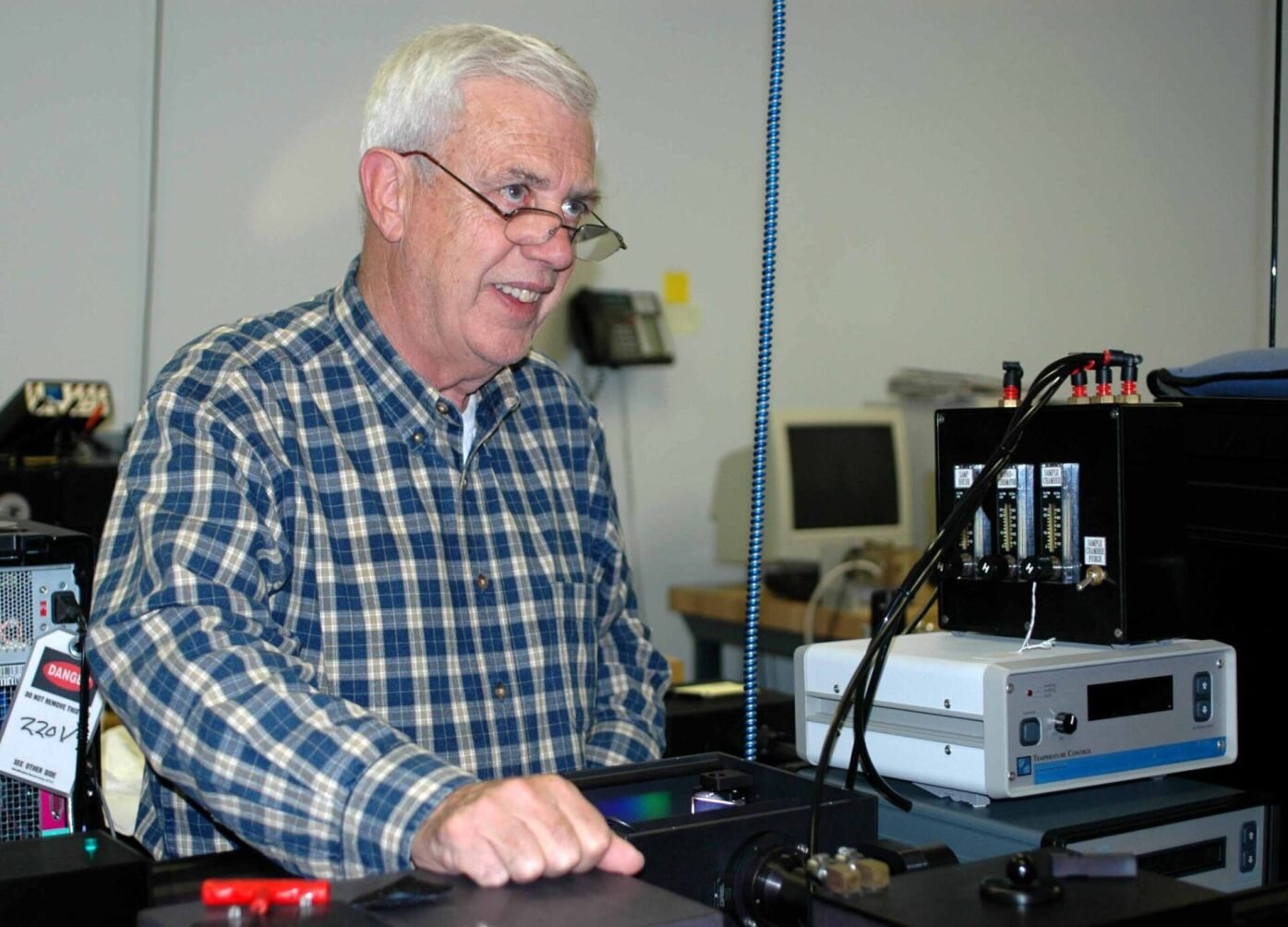Spectrophotometers Can Be Fun For Anyone
Spectrophotometers Can Be Fun For Anyone
Blog Article
Not known Facts About Spectrophotometers
Table of ContentsUv/vis Can Be Fun For EveryoneLittle Known Facts About Spectrophotometers.Getting The Circular Dichroism To Work8 Easy Facts About Uv/vis ShownUv/vis/nir - TruthsExcitement About Uv/vis/nirGetting My Circular Dichroism To WorkAn Unbiased View of Circular DichroismThe 10-Second Trick For Circularly Polarized LuminescenceNot known Facts About Uv/visThe smart Trick of Circularly Polarized Luminescence That Nobody is DiscussingSee This Report about SpectrophotometersThe Circularly Polarized Luminescence Diaries
It is then scanned through the sample and the referral services. Portions of the incident wavelengths are transmitted through, or shown from, the sample and the reference. Electronic circuits convert the relative currents into direct transmission portions and/or absorbance/concentration values.The transmission of a referral compound is set as a baseline (datum) worth, so the transmission of all other compounds are taped relative to the initial "zeroed" substance. The spectrophotometer then transforms the transmission ratio into 'absorbency', the concentration of particular components of the test sample relative to the preliminary compound.
Since samples in these applications are not easily available in big quantities, they are specifically fit to being examined in this non-destructive strategy. In addition, valuable sample can be saved by making use of a micro-volume platform where as little as 1u, L of sample is required for complete analyses. A short description of the treatment of spectrophotometry consists of comparing the absorbency of a blank sample that does not include a colored substance to a sample which contains a colored compound.
How Uv/vis/nir can Save You Time, Stress, and Money.
In biochemical experiments, a chemical and/or physical home is chosen and the procedure that is used specifies to that residential or commercial property in order to obtain more information about the sample, such as the quantity, pureness, enzyme activity, etc. Spectrophotometry can be used for a number of methods such as figuring out optimal wavelength absorbance of samples, determining optimum p, H for absorbance of samples, determining concentrations of unknown samples, and determining the p, Ka of numerous samples.: 21119 Spectrophotometry is likewise a useful process for protein filtration and can also be used as a technique to develop optical assays of a substance.
It is possible to understand the concentrations of a 2 part mix utilizing the absorption spectra of the basic options of each part. To do this, it is needed to understand the termination coefficient of this mix at 2 wave lengths and the termination coefficients of services that include the known weights of the 2 components.

All About Spectrophotometers
Many spectrophotometers are used in the UV and visible areas of the spectrum, and a few of these instruments also operate into the near-infrared area too. The concentration of a protein can be estimated by determining the OD at 280 nm due to the existence of tryptophan, tyrosine and phenylalanine (https://disqus.com/by/julieanndesalorenz/about/).
Nucleic acid contamination can also interfere. This method requires a spectrophotometer capable of measuring in the UV region with quartz cuvettes.: 135 Ultraviolet-visible (UV-vis) spectroscopy involves energy levels that excite electronic transitions. Absorption of UV-vis light delights molecules that remain in ground-states to their excited-states. Visible region 400700 nm spectrophotometry is utilized extensively in colorimetry science.
These curves can be used to evaluate a new batch of colorant to check if it makes a match to requirements, e
Traditional visible standard spectrophotometers area not detect if a colorant or the base material has product. This can make it difficult to handle color issues if for example one or more of the printing inks is fluorescent. There are two significant setups for visual spectrum spectrophotometers, d/8 (round) and 0/45.
Scientists use this instrument to determine the amount of substances in a sample. If the compound is more concentrated more light will be taken in by the sample; within little ranges, the Beer, Lambert law holds and the absorbance between samples vary with concentration linearly. In the case of printing measurements two alternative settings are typically used- without/with uv filter to control better the result of uv brighteners within the paper stock.
How Spectrophotometers can Save You Time, Stress, and Money.
Some applications need small volume measurements which can be carried out with micro-volume platforms. As described in the applications area, spectrophotometry can be utilized in both qualitative and quantitative analysis of DNA, RNA, and proteins. Qualitative analysis can be utilized and spectrophotometers are used to record spectra of compounds by scanning broad wavelength areas to identify the absorbance properties (the intensity of the color) of the substance at each wavelength.

Our Circularly Polarized Luminescence Statements
One major aspect is the type of photosensors that are offered for various spectral regions, however infrared measurement is also tough due to the fact that essentially everything produces IR as thermal radiation, particularly at wavelengths beyond about 5 m. Another issue is that many products such as glass and plastic absorb infrared, making it incompatible as an optical medium.
Retrieved Dec 23, 2018. Essential Laboratory Techniques for Biochemistry and Biotechnology (2nd ed.). The important guide to analytical chemistry.
Chichester, NY: Wiley. pp. 1617. ISBN 9780471974123. OCLC 36543293. Ninfa AJ, Ballou DP (2004 ). Basic laboratory techniques for biochemistry and biotechnology. Hoboken: Wiley. p. 66. ISBN 9781891786006. OCLC 633862582. Rendina G (1976 ). Philadelphia, PA: W. B. Saunders Company. pp. 46-55. ISBN 0721675506. OCLC 147990. Oke, J. B.; Gunn, J. E.
Everything about Uv/vis/nir
"Secondary basic stars for absolute spectrophotometry". The Astrophysical Journal. 266: 713. Bibcode:1983 Ap, J..266..713 O. doi:10. 1086/160817. Ishani, G (2006 ). "The very first commercial UV-vis spectrophotometer". p. 100. Recovered Dec 23, 2018. Simoni, RD; Hill, RL; Vaughan, M; Tabor, H (Dec 5, 2003). "A Traditional Instrument: The Beckman DU Spectrophotometer and Its Creator, Arnold O.
278 (49 ): e1. doi:. ISSN 1083-351X. Beckman, A. O.; Gallaway, W. S.; Kaye, W.; Ulrich, W. F. (March 1977). "History of spectrophotometry at Beckman Instruments, Inc". Analytical Chemistry. 49 (3 ): 280A300A. doi:10. 1021/ac50011a001. "Hewlett Packard: Compound Recognition with HP 8450 A UV Noticeable Spectrophotometer". Analytical Chemistry. 51 (12 ): 1188A1189A. 1979-10-01.
Ninfa AJ, Ballou DP, Benore M (2015 ). Basic Laboratory Methods for Biochemistry and Biotechnology (3, rev. ed.). UV/Vis/NIR. Laboratory Equipment.
Fascination About Circular Dichroism
"Applied Spectrophotometry: Analysis of a Biochemical Mixture". Biochemistry and Molecular Biology Education. Journal of Biochemistry Education.
Some Known Incorrect Statements About Uv/vis/nir
U.S. Department of Commerce National Bureau of Standards unique publication; 378. Washington, D.C.: U.S. National Bureau of Standards.
The procedure starts with a regulated source of light that brightens the evaluated sample. In the case of reflection, as this light interacts with the sample, some is taken in or discharged. The given off light travels to the detector, which is analyzed, quantified, and provided as industry-standard color blog scales and indices.
Market governing bodies usually specify particular metrics for specific items, such as Tomato and Coffee indices. The streamlined math appears like this: Where R is the reflection coefficient. All terms are examined over the visible spectrum from 400 to 700 nm. In the case of transmission, when the light interacts with the sample, it is either soaked up, reflected, or transmitted.
The Definitive Guide for Circularly Polarized Luminescence
Examples include APHA (American Public Health Association) for watercolor and pureness analysis, ASTM D1500 for petrochemical color analysis, edible oil indices used in food, and color analyses of beverages. All terms are examined over the visible spectrum from 400 to 700 nm.
Image Credit: Matej Kastelic/ Dr. Arnold J. Beckman and his coworkers at the National Technologies Laboratories initially invented the spectrophotometer in 1940. In 1935 Beckman established the company, and the discovery of the spectrophotometer was their most ground-breaking development. Dr. Bruce Merrifield, a Nobel prize-winning biochemist, specified that the creation of the spectrophotometer was "probably the most important instrument ever established towards the development of bioscience." Before the discovery of the spectrophotometer, chemical analyses took weeks to finish, with 25% accuracy.
An Unbiased View of Spectrophotometers
99% precision. Gradually, scientists kept enhancing the spectrophotometer style to improve its performance. For example, the UV abilities of the design B spectrophotometer were enhanced by replacing the glass prism with a quartz prism. Ultimately, the Design DU was produced, containing a hydrogen light and other improvements. This instrument was utilized in commercial laboratories, centers, and chemistry and biochemistry departments.
Normally, a spectrophotometer is made up of 2 instruments, namely, a spectrometer and a photometer. A fundamental spectrophotometer consists of a light source, a monochromator, a collimator for straight light beam transmission, a cuvette to put a sample, and a photoelectric detector.
The 9-Second Trick For Circular Dichroism
There are various types of spectrophotometers in different sizes and shapes, each with its own purpose or performance. A spectrophotometer determines just how much light is shown by chemical parts. circular dichroism. It measures the distinction in light intensity based on the overall quantity of light introduced to a sample and the amount of light beam that passes through the sample option
A spectrophotometer is utilized to figure out the concentration of both colorless and colored solutes in a solution. This instrument is used to figure out the rate of a response.
Report this page